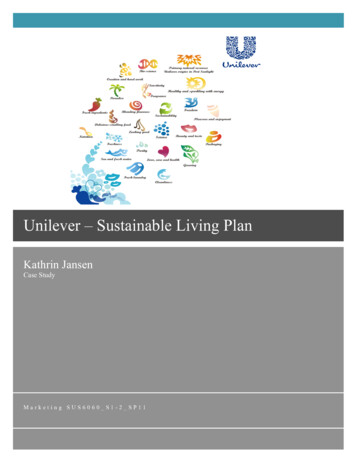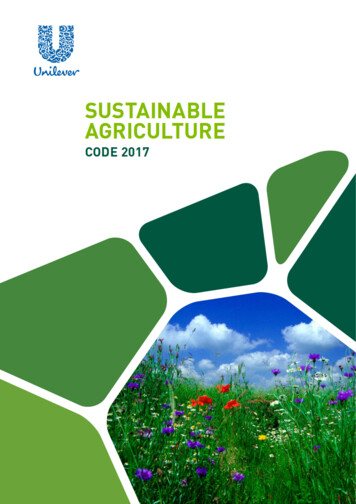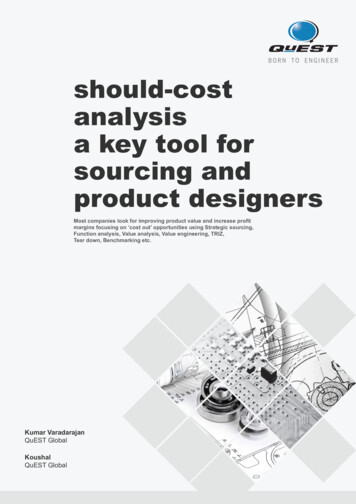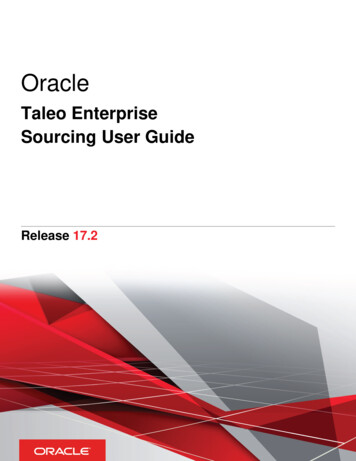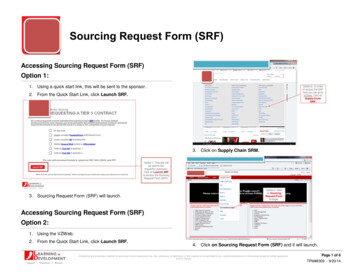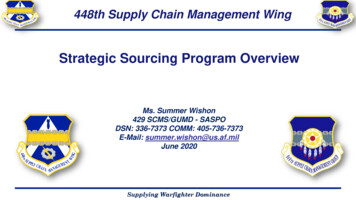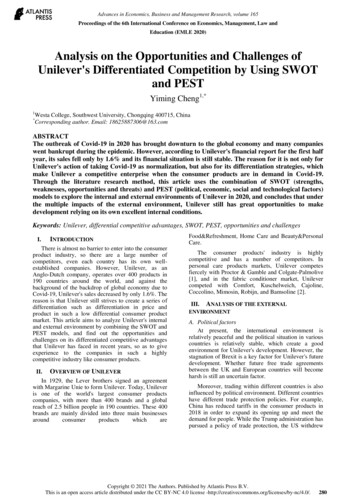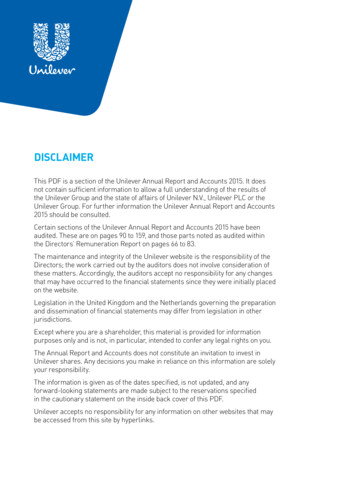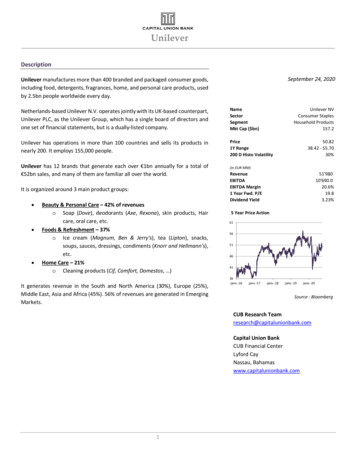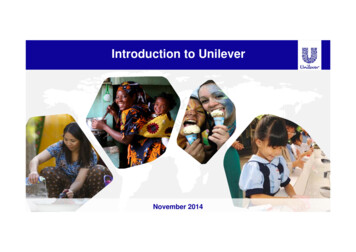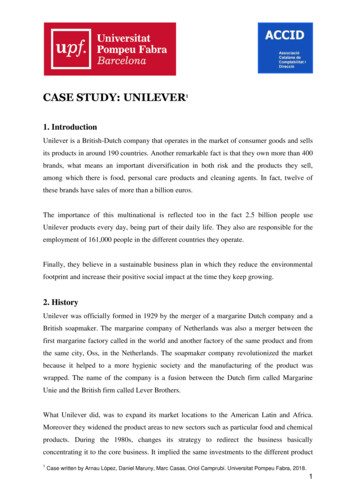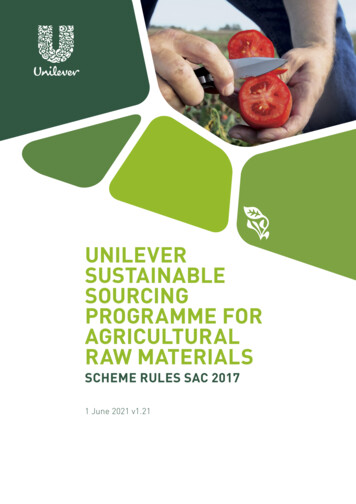
Transcription
UNILEVERSUSTAINABLESOURCINGPROGRAMME FORAGRICULTURALRAW MATERIALSSCHEME RULES SAC 20171 June 2021 v1.21
CONTENTS1INTRODUCTION 36USE OF SUPPLIER OR INDUSTRY-LEVEL1.1 Background 3SUSTAINABILITY PROGRAMMES 111.2 Scope of the Programme 36.1 TYPES OF SYSTEM IN USE 111.3 Who is This Document for? 36.2 BENCHMARKING OF SUPPLIER-OWN1.4 Other Relevant Documents 31.5 Document Control 31.6 Transition Period 3PROGRAMMES 116.3 ASSURANCE OPTIONS FOR SUPPLIER-OWNPROGRAMMES WHICH DO NOT HAVE FULLTHIRD-PARTY VERIFICATION 2USE OF THE SUSTAINABLE AGRICULTURE116.4 AUDIT PROCESS FOR SUPPLIER-OWNCODE – SAC 2017 42.1 General Conditions 42.2 Required Compliance Levels 4PROGRAMMES (COMPLIANCE ROUTE) 116.5 ASSESSMENT PROCESS FOR SUPPLIERSYSTEMS SHOWING IMPACT (IMPACT ROUTE) 123THE SAC CERTIFICATION PROCESS 53.1 Basic Principles 53.2 Frequency of Audits 53.3 Scope of Supplier (AMS) Audits 57GLOSSARY OF TERMS 8ANNEX IA – STANDARDS CONSIDERED FULLY3.4 Sampling Rules – Selection of Farms forCOMPLIANT WITH THE PRINCIPLES ANDAuditing 53.5 Scope of Farm Audits 14PRACTICES OF SUSTAINABLE AGRICULTURE 3.6 Results of Audits and Calculation of Suso9Volume 6ANNEX IB – INDUSTRY-LEVEL STANDARDSCONSIDERED FULLY COMPLIANT WITH3.7 Non-Conformances And Corrective Actions 6THE PRINCIPLES AND PRACTICES OF3.8 Certificate Validity 6SUSTAINABLE AGRICULTURE 3.9 SURVEILLANCE AUDITS 63.10 Provision of Metrics Data 73.11 Summary of Certification Cycle 8SUPPLY CHAIN OPTIONS 94.1 Identity Preservation (IP) 94.2 Segregation (SG) 9CORRECTIVE ACTION PROCESSES 224.3 Mass Balance (MB) 911.1 Process for SAC Audits 221810 ANNEX II – STANDARDS CONSIDERED PARTIALLYCOMPLIANT WITH THE PRINCIPLES ANDPRACTICES OF SUSTAINABLE AGRICULTURE 41554.4 Supporting Administrative SystemRequirements and Conditions 1911 ANNEX A – DETAILS OF NON-CONFORMANCE AND11.1.1 Communication of Non-Conformances9 2211.1.2 Timing for Correcting5USE OF OTHER CERTIFICATION SCHEMES 105.1 General Principles 105.2 Certification Schemes or StandardsNon-Conformances 2211.1.3 Evaluation of Corrective Actionsand Certification Decision 22Considered Fully Compliant with the Principlesand Practices of Sustainable Agriculture 105.3 Certification Schemes or StandardsConsidered Partially Compliant with thePrinciples and Practices of SustainableAgriculture 102Unilever Sustainable Sourcing Programme for Agricultural Raw Materials Scheme Rules 1 June 2021 v1.21
1 INTRODUCTION1.1 BACKGROUND1.3 WHO IS THIS DOCUMENT FOR?The first Sustainable Agriculture Code was published ina.This document explains the processes involved2010, and has been used as both the basis for a self-as-in being able to count a purchased raw materialsessment programme with Unilever suppliers, and asas ‘Sustainably Sourced’1. It is aimed at Unilevera standard against which to benchmark other externalProcurement Managers and their Suppliers.sustainability schemes and supplier own managementb.systems.Suppliers in transition from SAC 2010 to SAC 2017should refer to ‘Unilever Sustainable SourcingProgramme for Agricultural Raw Materials, SchemeThese scheme rules accompany the update to that code –Rules (Transition Period).SAC 2017. In updating the system, we have made severalchanges to the way that assessment against the SAC is1.4 OTHER RELEVANT DOCUMENTScarried out:a.Unilever Sustainable Agriculture Code SAC 2017-b.Unilever Sustainable Agriculture Code SAC 2017Assessment at Agricultural Management System(AMS) level rather than raw material level-Certification rather than verified self-assessmentImplementation Guidec.Protocol for Wild-Harvested materialsThe SAC includes requirements aimed at the owner of the1.5 DOCUMENT CONTROLAMS. We call these ‘Supplier’ questions but recognise thata.The latest version of these rules can be found onvarious actors can play a role in the AMS, e.g. cooperatives,the Unilever website. The document will be updatedlocal farming groups.annually, although minor changes, e.g. additions toAnnexes will be made more frequently. A summary ofchanges made during updates will also be available1.2 SCOPE OF THE PROGRAMMEWe have decided to focus on a set of priority crops andon the website.b.Version number: A change in the first digit representscommodities from 2017 onwards, selected according toa significant change to the document – a new version.their importance to our business and our brands, as wellA change to the second digit represents a minoras our ability to have a greater positive impact. Thesechange, e.g. correction of a typographical error orpriority crops are:addition of benchmarked certification standard to oneof the Annexes.Palm OilOilseed RapePaper and BoardCocoa1.6 TRANSITION PERIODSoyDairya.SugarCerealsCode or these scheme rules (major changes only) areTeaHerbal Infusionspublished, suppliers and their farmers will have aVegetablesVanillatransition period of 12 months from the date of publi-When new revisions of the Sustainable Agriculturecation, within which to comply with any changes.1 The only exception to this is Wild-Harvested materials,which are assessed by a different process.3
2 USE OF THE SUSTAINABLE AGRICULTURE CODE– SAC 2017SAC 2017 can be used for any crop in any region. Compliance with the Code will be audited by a third-partyCertification Body (CB), which will be selected by Unilever.2.1 GENERAL CONDITIONSa.SAC 2017 is made up of ‘Supplier’2 requirements and‘Farmer’ requirements.b.‘Supplier’ requirements need to be complied with bythe owner of the agricultural management system3under which the raw materials are produced. This willusually be the primary processing plant from whichUnilever (or Unilever suppliers) buy raw material(s).c.‘Farmer’ requirements need to be complied with byall farms who are currently producing raw material(s) purchased by Unilever under that agriculturalmanagement system (AMS).2.2 REQUIRED COMPLIANCE LEVELSa.SAC 2017 is made up of three types of requirements:a. Mandatory requirementsb. Expected requirementsc. Leading requirementsb.To be considered compliant with the SAC, anAgricultural Management System (measured by thecombination of Supplier and Farmer requirements)needs to achieve the following scores:Mandatory100% of all applicable requirementsExpected70% of all applicable requirementsLeadingNo minimum percentage required2 Supplier refers to suppliers to Unilever, though as noted above somesupplier requirements may be dealt with by other organisations e.g.cooperatives.3 A management system is the framework of policies, processes andprocedures used by an organisation to ensure that it can fulfill all thetasks required to achieve its objectives. In the case of an AgriculturalManagement System this aims to ensure consistent practice across agroup of farmers.4Unilever Sustainable Sourcing Programme for Agricultural Raw Materials Scheme Rules 1 June 2021 v1.21
3 THE SAC CERTIFICATION PROCESSBefore a raw material from a particular AMS can be deemed ‘Sustainably Sourced’ for Unilever’s purposes, acertification audit must have been carried out with both the Supplier and Farmers (see 2.1(b) and (c) above)to check compliance with the requirements of SAC 2017. Metrics data must also have been provided for allraw materials produced for Unilever under that management system (see Section 3.10 on page 6).3.1 BASIC PRINCIPLESa.b.Certificates are awarded at AMS level, i.e. to the3.4 SAMPLING RULES – SELECTION OF FARMSFOR AUDITINGSupplier rather than to individual farmers and applya.sample is taken or not depends on the total numberAMS.of farms in the management system for the rawIf a farmer supplies more than one Supplier (AMS)material(s) in question.with the same raw material, a positive audit resultc.Sampling is permitted at the farm level. Whether ato all relevant raw materials produced under thatb.The number of farms to be sampled for initial auditscan be used by all Suppliers.per management system is determined by theCertification audits will be carried out and managedfollowing rules:using the Greenlight Assessment (GLA) softwarei.system. All suppliers using the SAC directly will haveii. If the number of farms (n) is 10 a sample ofaccess to GLA.If there are fewer than 10 farms, all are audited.10 or n will be audited, whichever is higher.This means that 10 farms will be audited unless3.2 FREQUENCY OF AUDITSn 100. If the square root calculation results in aa.A certificate will be issued and re-issued every 3 yearsnon-whole number, the following rounding rulesbased on initial and re-evaluations on complianceapply: if decimal is 0.5 or more then round up towith the SAC requirements. Continuous compliancenext whole number, if less than 0.5 round down.will be evaluated annually through surveillance auditsiii. The maximum number of farm audits that shall be(see Section 3.8 on page 6).required is 50.c.The sample of farms will be random, and the selec-3.3 SCOPE OF SUPPLIER (AMS) AUDITStion will be made by the CB from the total list ofa.All Suppliers will be audited.farms, which shall be provided by the supplier.b.The CB will inspect the complete checklist of Supplierc.requirements (Mandatory and Expected require-3.5 SCOPE OF FARM AUDITSments) as well as documentation relating to the AMS.a.The CB will inspect any administrative systemFarmer requirements (Mandatory and Expectedrequired to support the use of Segregation (partialAMS coverage) or mass balance (see Section 4 onpage 9).d.The CB will inspect the complete checklist ofrequirements).b.The scope of the audit includes:i.Areas of the farm that are legal property of theThe CB will check that farm-level metrics data hasfarmer, or which are leased by the farmer, andbeen provided for the required number of farms (seewhich are either destined for agricultural use,next section) for each of the raw materials covered bynatural land and aquatic ecosystems, land coveredthe management system.by high-value ecosystems or fallow land.ii. Workers and people who live temporarily orpermanently on the farmiii. Documentation and data relating to social,agronomic and environmental management.5
3.6 RESULTS OF AUDITS AND CALCULATION OFSUSO VOLUME3.7 NON-CONFORMANCES AND CORRECTIVEACTIONSThe details of the process governing the communication3.6.1a.Conditions for AMS Complianceand correction of non-conformances identified duringAn AMS is considered compliant, and the associatedaudits is described in Annex A on page 22.raw material(s) Suso, when the compliance levelsb.in Section 2.2 are reached, i.e. 100% of Mandatory3.8 CERTIFICATE VALIDITYrequirements and 70% of Expected requirements.a.An AMS is considered ‘compliant with conditions’audit has a 36-month validity, starting with the date ofunder the following circumstances:issue.a. If any individual farm or farms has 5 or fewerb.Mandatory non-conformances (NCs)following cases:30% and 70% on Expected requirementsi.Under these circumstances, farms will need toii. A maximum of three months, when the organi-Any individual farm who has more than 5 Mandatorysation is going through an appeal process, whenNCs and/or scores less than 30% on Expectedthe certification decision was to suspend therequirements will be suspended from the AMS untilcertificate.NCs have been corrected (by the next audit at thee.Up to a maximum of six months in the event of a‘force majeure’ situation.address the NCs as in Section 11.1.2 on page 22.d.The expiry date of the certificate is definitive, but thevalidity of the certificate could be extended in theb. If any individual farm or farms score(s) betweenc.The certificate awarded on the basis of the initialiii. Up to three months in the case of organisationsearliest).that have undergone a re-certification audit priorThe % volume from an AMS with suspended farmersto termination of the 36-month cycle, and thewill be calculated as follows:certification decision has not been made by the% Suso Total no. farmers in sample no. suspended farmersTotal no. farmers in sampleCB. This effectively means that the certificate hasa maximum validity period of 39 months.x 100c.The certificate may be suspended if a breakdown inthe management system (fail) is identified during aIn the case of an AMS audit that results in 100%surveillance audit. Re-instatement of the certificate isSuso, the AMS can decide to either:based upon satisfactory closure of NCs that have ledi)to the suspension.re-audit the whole AMS within 36 months asnormal, with the 100% Suso result being usedthroughout that 36 month period or3.9 SURVEILLANCE AUDITSii) re-audit suspended farms once NCs have beencorrected to increase the Suso %.If they choose option i) surveillance audits willEligibility for Surveillance Audita.The purpose of surveillance audits is to check that thecontinue to be carried on the remaining (non-sus-conditions of certification are still in place, to allowpended) farms as described in Section 3.9.‘continuous compliance’. They can only be used ifthe Supply Chain is relatively stable over the 3-year3.6.2 Conditions for AMS Non-Compliancea.b.An AMS is considered ‘not compliant’ if more thancertification period.b.If fewer than 20% of the original farms (i.e. those50% of farms in the AMS or sample (if relevant)listed in the Supply Chain in Year 1 when the full audithave been suspended due to high levels of eitherwas carried out) remain in the AMS in either year 2Mandatory or Expected failures (as in point d) aboveor 3 then a new set of full audits will be required, asIn such cases, the CB will consider that there hasin Sections 3.4 and 3.5, and a new 3-year certifica-been a breakdown in the management system, andtion cycle will begin. The same rule would apply ifthere will be an automatic failure for the AMS, whichthe number of farmers increased substantially. Forwill be re-audited the following year. No volume fromexample, if the number of farms increased from 10 inthe AMS will count as Suso.year 1 to more than 50 in year 2 (with the original 10thus making up less than 20% of the total) a new setof audits would be required.6Unilever Sustainable Sourcing Programme for Agricultural Raw Materials Scheme Rules 1 June 2021 v1.21
c.If the above requirement is satisfied, but the list of3.10 PROVISION OF METRICS DATAfarms in the management system has still changeda.to the point where not enough of the ‘originallymetrics data each year before the next audit, i.e. at 0,audited’ farms are available for surveillance audit, therequired number of ‘new’ farms will be included fromthe supply chain (see point e. below).A number of farms in the AMS will need to provide12 and 24 months in the cycle.b.The provision of this data will be checked by theauditor and will be a condition of compliance. Theminimum requirement for compliance will be that theSurveillance Audit Processsame number of farms as in the sample (see sectiond.Surveillance audits will be carried out each year3.4) have provided data. These do not necessarily havewhere there is no full audit (i.e. in years 2 and 3 of theto be the exact farms in the sample.audit cycle) on each AMS.e.Surveillance audits will focus on farm practice – thesample of farms for surveillance auditing will bedrawn from the sample audited in year 1 (x), at a rateof 0.3x, i.e. approximately one third of farms auditedin year 1 will be subject to a surveillance audit. Ifthe square root calculation results in a non-wholenumber, the following rounding rules apply: if decimalis 0.5 or more then round up to next whole number, ifless than 0.5 round down.f.Surveillance audits will include a desk review ofthe supplier’s management system, a check on allapplicable Mandatory Farmer requirements, plus 50%of all applicable Expected Farmer requirements. Thedecision of which Expected requirements to includewill be made by the CB. However, any ‘new’ farmincluded will require a complete assessment as inSection 3.5.g.Certificates will be maintained or suspendeddepending on the results of a surveillance audit.h.Corrective actions for non-conformances may berequired as in Section 3.6.i.Suspended certificates will be re-instated basedupon satisfactory closure of NCs that have led to thesuspension. Expiry date of the certificate remains thesame.7
3.11 SUMMARY OF CERTIFICATION CYCLEa.Table 1 summarises the steps involved in the fullcertification cycle.Step no.ActivityTiming1Supply chain information entered/updated intoGreenlight Assessment System.Before audits arranged (first year), after 12 months(subsequent years)2Sample of farmers in management system drawn by CBOnce CB has received notification of completion of supply chaintask and any relevant certificates have been uploaded3Metrics data collected by supplier for a number of farmsin the AMS (at least the same number as in the samplefor the full audit)Before the date of the audit4First full certification audit inspections (supplier site andsample of farms) including check on provision of metricsdataBy arrangement by CB (Year 1)5Audited organisations informed of anynon-conformancesAt closing meeting (verbally) and within 5 days of final audit(in writing)6Any Mandatory NCs corrected and evidence provided tothe CBWithin 42 days of the auditor submitting the assessments tothe certifier in the GLA System7Corrective action evaluation and Certification decision(on the basis of Expected NCs being corrected with in therequired period, if applicable)Within 10 days of Step 4 or 6, whichever is later8Certificate issued by the Certification BodyWithin 7 days of the certification decision being made9Number of Expected NCs to reach required compliancelevel corrected and evidence provided to the CBWithin 6 months of the auditor submitting the assessments tothe certifier in the GLA System10Interim year metrics data provision (minimum number the number of farms in the Year 1 full audit sample)Before the date of the audit11Surveillance auditsBetween 9-15 months and 21-27 months after certification date12Second full certification audit inspections (supplier siteplus new sample of farms)36 months after certification date (unless required sooner dueto significant changes in the supply chain in interim years)Table 1 – Summary of Steps in Certification Cycle8Unilever Sustainable Sourcing Programme for Agricultural Raw Materials Scheme Rules 1 June 2021 v1.21
4 SUPPLY CHAIN OPTIONSThe following sections describe the different supply chain options permitted for use under the UnileverSustainable Sourcing Programme and the administrative requirements needed to underpin their credibleuse.4.1 IDENTITY PRESERVATION (IP)blending) and iii) group, or multi-site level (withAlso known as ‘hard IP’ or ‘track and trace’conditions - see below).a.Sustainable material can be traced back to a singleb.Each batch of Sustainable material is treated sepa-4.4 SUPPORTING ADMINISTRATIVE SYSTEMREQUIREMENTS AND CONDITIONSrately and clearly separated from other batches ofa.Unilever’s preference is for segregated supply chains.Sustainable and non-Sustainable material.b.Mass balance is permitted for use within the Unileverpoint of originProgramme, but only in the context of the following4.2 SEGREGATION (SG)hierarchy of preferred supply chain options:Also known as ‘bulk commodity’ or ‘soft IP’1. Continued preference for segregated supply chaina.2. Single site mass balance, when segregated supplySustainable material is kept physically separate fromnon-Sustainable material through each stage of theis not feasiblesupply chain3. Multi-site mass balance when single-site massb.Different batches of Sustainable material can bebalance is not feasible, only following SSACmixed, but not Sustainable and non-Sustainable.approval and only if the following conditions arec.A variant of segregation, where only a subset of themet:farmers are involved in the Sustainability programme,·[bullet point] In the case of supplier-ownbut their Sustainable material is kept physicallysustainability systems, only if the farmerseparate from that of the ‘non-Suso’ farmers, issupply base is homogeneous and contiguousallowed by Unilever. We refer to this as ‘Segregationand if there is annual independent verification- partial (SP)’ When all farmers are involved in theof the administrative systemprogramme, we call this ‘Segregation - full (SF)’. If SP·In the case of 3rd party certification, if theis used, a verifiable administrative system must be inScheme’s Chain of Custody standard recog-place.nises multi-site mass balance as a supplychain type, with annual auditing/verification bya third party.4.3 MASS BALANCE (MB)4. If segregated or restricted mass balance asMass balance is an overarching term for various slightlyabove not possible, accept crop certificates (e.g.different systems, which all involve balancing volumeBonsucro or Round Table for Sustainable Soy),reconciliation.where financial incentive is given to farmers toa.adopt sustainable practices, even though the rawSustainable and non-sustainable materials can bemixed physically, but must be kept separate withina company’s accounting system, i.e. amounts andb.c.material does not reach Unilever supply chains.c.Any supplier using mass balance needs to have inproperties of each are recorded.place a verifiable administrative system to ensure thatAccounting system ensures that volumes ofno double-counting (i.e. ‘selling’ sustainable mate-Sustainable material sold does not exceed volumes ofrials to more than one purchaser) can take place.Sustainable material produced or purchasedAdministrative systems are required for both physicalVolumes can be balanced at different levels: i) batchraw material and certificates.level (sometimes known as percentage blending);ii) single site level (sometimes known as controlled9
5 USE OF OTHER CERTIFICATION SCHEMES5.1 GENERAL PRINCIPLESa.production. Many other sustainable agriculture codes5.3 CERTIFICATION SCHEMES OR STANDARDSCONSIDERED PARTIALLY COMPLIANTWITH THE PRINCIPLES AND PRACTICES OFSUSTAINABLE AGRICULTUREand certification schemes are in use and Unilevera.SAC 2017 lays down the principles and practicesUnilever see as key to sustainable agriculturalAnnex II on page 19 contains external standardsassesses the equivalence of these schemes with thewhich have been benchmarked but which are notprinciples and practices of sustainable agricultureconsidered fully compliant with the principles andthrough a comprehensive benchmarking process.practices of sustainable agriculture - they coverb.Benchmarking is required for all external codes andseveral but not all of the SAC Chapters.c.If a supplier or farmer has any doubt or griev-codes in Annex II, they will need to fill the gaps notance with respect to our benchmarking of eithercovered, e.g. through the auditing process describedan external standard or in-house/industry-levelin Section 3, but only for the chapters required.schemes and for internal, supplier-own systems.programme, please email sustainable.agricult@unilever.com.b.c.If suppliers are compliant with the standards orIf a supplier is using a standard or code that is notlisted in Annex II they can request, via their Unilevercontact, for a benchmark to be carried out.5.2 CERTIFICATION SCHEMES OR STANDARDSCONSIDERED FULLY COMPLIANT WITHTHE PRINCIPLES AND PRACTICES OFSUSTAINABLE AGRICULTUREa.Any material from farms that have been certifiedagainst standards and codes recognised by Unileveras fully compliant with the principles and practices of sustainable agriculture, qualifies as being‘sustainably sourced’. The current list of recognisedexternal standards and codes is given in Annex IAon page 15. The list of recognised industry-levelprogrammes is given in Annex IB on page 18.b.Suppliers wishing to use Annex IA standards in placeof SAC 2017 will be responsible for providing Unileverwith up to date evidence of certification (includingany Chain of Custody Standard required as part of thescheme) for the raw material in question.c.Suppliers wishing to use Annex IB programmes inplace of SAC 2017 will have to provide evidence ofinclusion in the programme, as well as any additionalrequirements noted in the comments column inAnnex IB.10Unilever Sustainable Sourcing Programme for Agricultural Raw Materials Scheme Rules 1 June 2021 v1.21
6 USE OF SUPPLIER OR INDUSTRY-LEVELSUSTAINABILITY PROGRAMMES6.1 TYPES OF SYSTEM IN USEa.b.sustainability programmes are used by Unilever6.3 ASSURANCE OPTIONS FOR SUPPLIER-OWNPROGRAMMES WHICH DO NOT HAVE FULLTHIRD-PARTY VERIFICATIONSuppliers.a.Several Supplier-owned, Industry-owned or regionalSome of these programmes are based on third-partyaudited certification schemes but with additionalelements. Others are based on internal systemswhose systems are not fully third-party verified.Assurance Optionswhich may be first, second or third-party assured.Compliance RouteImpact RouteMany of these schemes rely, in part at least, onAny SAC requirements thatare not covered by a thirdparty verified standard will beaudited according to the rulesin Section 3 on page 5.Supplier must agree tomonitor and evaluate KPI(s)that address pertinent issuesin their supply base. Evidence required of practicechange across farmer basee.g. % farmers using covercropping and outcomeimprovement e.g. waterquality, GHG emissions Agreement of what credibleevidence will be providedwill need to be approved inadvance by the SSACnational or regional legislation for compliance.6.2 BENCHMARKING OF SUPPLIER-OWNPROGRAMMESa.Table 2 shows the options available to suppliersBenchmarking of Supplier-own, Industry-owned orregional sustainability programmes is required asdescribed in Section 5.1.b.A template based on SAC 2017 will be provided to thesupplier who will document how each of the requirements are covered by their programme. They will alsoc.note how compliance is verified (third party, secondTable 2 – Assurance Options for Supplier-Ownparty etc.).ProgrammesIf the programme is not considered compliant withture, the supplier will either need to add elements to6.4 AUDIT PROCESS FOR SUPPLIER-OWNPROGRAMMES (COMPLIANCE ROUTE)the programme to ensure coverage of requirementsSection 3 on page 5 gives details of the audit process. Anyat the required level, or design impact programmes todifferences for Supplier-own programmes are noted in theaddress gaps (see Section 6.5 below for details).following sections.the principles and practices of sustainable agricul-d.If a programme is compliant with the principlesand practices of sustainable agriculture AND there6.4.1 Basic Principlesis third-party verification, then the programme isa.Certificates will not be awarded to suppliers usingb.The purpose of the audit is to give Unilever the assur-considered ‘certified’ against the internal standardand no further action is required, other than toe.their own internal systems.provide evidence to Unilever that the materialance that raw materials covered by Supplier-ownsupplied is verified under the programme.programmes are produced in accordance with theIf the programme does not have third-party verificationprinciples and practices of sustainable agriculture,of the whole programme, they will need to choose fromas described in the benchmark, and can therefore beone of the assurance options in Section 6.3 below.claimed as Sustainably Sourced.c.Audits will be carried out by Control Union and will bepaid for by Unilever.11
6.4.2 Timing and Frequency of Audit6.5.3 Step 2 – Programme Developmenta.a.Timing and frequency of audits will be as described inSection 3.2Based on the identified risks and/or areas of relativeweakness identified in the programme, the supplier willdesign a programme to address that issue, selecting6.4.3 Scope of Auditsa.b.c.d.All Suppliers who use an internal programme and whoboth outcome and impact indicators to report on.b.A clear mechanism for impact, or ‘theory of change’choose the ‘compliance route’ will be audited. A sampleshould exist, linking the risk or issue, the interventionof their farmers will also be audited, as in Section 3.4and the outcome indicator. Guidance on designingThe CB will inspect the complete list of requirementsan impact programme, using principles from ISEALwhich have been identified in the benchmark as notAlliance’s Impact Code is included in the Impactbeing covered by third party verification. This will varyProgramme Manual, which is available on requestfrom system to system.from sustainable.agricult@unilever.com. If massThe CB will also inspect aspects covered by legisla-balance is used in the system, the minimum require-tion that are referred to in the benchmark.ment is that the equivalent number of farmers thatNo metrics data will be required from suppliersare required to produce the Unilever volume shouldchoosing the ‘compliance route’.participate in the programme.c.6.5 ASSESSMENT PROCESS FOR SUPPLIERSYSTEMS SHOWING IMPACT (IMPACT ROUTE)The Suso manager and assurance team will discussthe risk assessment and impact programme withthe supplier, and if necessary, further develop theprogramme and KPI(s) to a satisfactory level. As6.5.1 Minimum Requirementspart of the programme development, the Suppliera.In order to follow the Impact route, the benchmarkwill need to agree on a date for the annual reportmust show that 100% Mandatory requirements and asubmission. The date should be chosen to fit withminimum of 50% Expected requirements are coveredany reporting cycles that the company has in place.by the programme. Impact programmes cannot beOnce agreed, the annual report on KPIs will need toused to fill gaps in areas covered by mandatorybe submitted by that date every year to maintain Susorequirements unless there is a well-recognisedstatus.issue that is endemic and intractable in a country ord.The risk assessment and KPI programme propositionindustry, e.g. child labour in cocoa in West Africa.will be finalised and submitted to the SustainableIn such cases, Unilever will consider accepting anSourcing Assurance Committee (SSAC) forimpact program to address the point, providing thisconsideration.includes a clear approach to address the i
4 Unilever Sustainable Sourcing Programme for Agricultural Raw Materials Scheme Rules 1 June 2021 v1.21 2 USE OF THE SUSTAINABLE AGRICULTURE CODE – SAC 2017 SAC 2017 can be used for any crop in any region. Compliance with the Code will be audited by a third-party Cer
